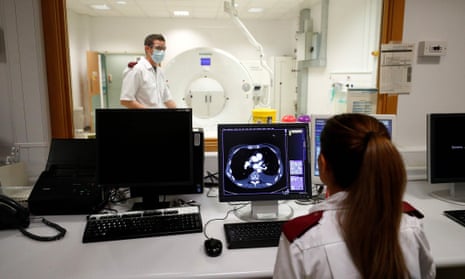Thousands of lives could be saved if people at risk of developing Britain’s deadliest cancer were screened to diagnose it before it becomes incurable, a major NHS study has found.
Giving smokers and ex-smokers a CT scan uncovers cancerous lung tumours when they are at an early enough stage so they can still be removed, rather than continuing to grow unnoticed, it shows.
Experts are demanding the government moves to bring in routine CT scanning of smokers and ex-smokers in order to cut the huge death toll from lung cancer. About 48,000 people a year are diagnosed with the disease in the UK and 35,100 die from it – 96 a day.
Lung cancer is a particularly brutal form of cancer because it is hard to detect and three out of four cases are diagnosed at stage three or four, when it is already too late to give the person potentially life-saving treatment.
However, the Summit study, being run by specialists in the disease at University College London Hospital NHS trust, offers real hope that lung cancer can become a condition that is detected early.
CT scanning meant that 70% of the growths detected in people’s lungs were identified when the disease was at stage one or two – a huge increase in the usual rate of early diagnosis.
“It’s really a major breakthrough for lung cancer,” Dr Sam Janes of UCLH, the senior investigator of the trial, told the Guardian. Lung cancer has never had anything that enabled us to detect this devastating cancer earlier and offer curative treatment to this number of lung cancer patients.”
“It’s important to highlight how effective CT scanning is. In my lung cancer clinic at UCLH, seven out of 10 people have cancer that’s been inoperable, incurable, from the first time they saw a doctor. Whereas with the cancers that we see with Summit, seven out of 10 are potentially curable, because they were detected earlier.
“We have many, many patients who can’t believe their luck that they’ve taken part because they’ve had their scan, they’ve had a nodule – an early cancer – detected, and then they’ve had surgery. People get out of hospital within three to five days and can get back to work or their usual routine within six weeks. That’s stopped them from presenting to a doctor maybe 18 months later with a cancer that has spread and is often incurable.”
Janes and his team found 180 cases of lung cancer among 12,100 smokers and ex-smokers aged 55-78 in north central and north-east London, many of whom were from poorer backgrounds. They volunteered to undergo what he called a “lung health MOT” when they received an invitation letter from their GP. Of those, 70% were uncovered when they were still at stage one or two.
Experts say the findings show that the government should move to bring in routine screening of smokers and ex-smokers in order to cut the horrendous death toll from the disease.
“Now that CT screening for lung cancer has been shown to work, we very much hope that a lung cancer screening programme will be introduced in England”, said Dr Robert Rintoul, the chair of the clinical advisory group of the UK Lung Cancer Coalition, a group of leading experts in the disease and patient charities.
“Lung cancer is the UK’s biggest cancer killer and early detection offers the best chance of curative treatment and saving more lives.” Screening could lead to a 25% fall in the number of men dying of lung cancer and 30-40% fewer deaths among women, he added.
“The Summit study will teach us more about how to successfully implement CT screening in a high-risk population”, Rintoul said.
Summit’s findings are due to be published in a medical journal later this year. They will add to the growing pressure on the UK National Screening Committee to bring in screening for lung cancer, at least among those who smoke or used to, in the same way that people in certain age groups are already invited for breast, bowel and cervical cancer. Previous studies in the US and Europe have also shown that CT scanning can find lung cancers that would otherwise have remained hidden.
The grim scenario lung cancer usually involves is underscored by Cancer Research UK’s finding that “lung cancer survival has not shown much improvement in the last 40 years in the UK”. Only 16% of sufferers live for five years after diagnosis and only 10% survive for 10 years.
The proportion of patients diagnosed at stage one or two rose from 19.5% in 2013 to 29% in 2019. However, about one in three are only diagnosed as an emergency, for example, when someone attends A&E, and 87% of such cases are already stage three or four.
NHS England is carrying out small-scale trials in which people, usually in poorer areas where smoking rates are highest, are offered the chance to have a CT scan to check their lungs, sometimes using a scanner in the back of a lorry in a supermarket carpark.
An NHS spokesperson said: “The NHS introduced lung cancer scanning trucks in supermarket car parks to screen those at risk of lung cancer and catching cancers early has remained a priority throughout the pandemic with 200,940 people referred for screening in December alone.”
